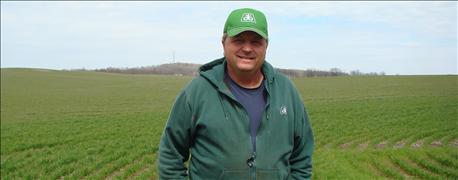May 25, 2016

Mike Morehouse is part of a diverse family farming operation in southern Elkhart County that includes his dad, Dean; brother Matthew; nephew Scott; and sons Brad and Jason. Together they farm 1,800 acres of corn, soybeans, occasional wheat, seed corn, hogs and beef cattle.
The farm was homesteaded by Mike Morehouse’s great-great-grandfather in 1866, and this summer it will be honored for 150 years in the family. For much of that time, Morehouse says the family has had an innovative bent.
“Our family’s always been geared to try new things,” he says. “Some things worked, some flopped, but in both cases, we learned.”

WILLING TO LEARN: New ideas don’t scare Mike Morehouse. To the contrary, he’s always ready to consider and try new things.
One area of that learning has been in tillage and conservation practices. These have evolved over the years, and currently all acres not in seed corn are either no-tilled or strip-tilled. The seed corn acres are minimum-tilled.
Cover crop bug
The Morehouses also got into cover crops seven years ago. Morehouse says their operation has 16 different soil types, with about half the acres being sandy soils that are irrigated. The other half has heavier soils, which extensive tiling has improved considerably; either 30- or 40-foot spacing on laterals has been installed.
The combination of irrigation and cover crops can provide some challenges, but Morehouse says the results have been worth the extra management effort.
“Cereal rye has been a particularly good fit for our sandy, droughty soils,” he says. “By having irrigation, we’re guaranteed of being able to get timely moisture in the fall on our cover crops, most of which are aerially seeded.
"Since growing cover crops, we can tell a difference in the amount of humus and tilth in our soils, and they’re mellower, with less soil compaction," he adds. "That’s important, because the kinds of yields farmers take off today burn up humus pretty fast. We’ve also been able to save some of our nutrients, which would have otherwise leached out of the soil.”
Boone writes from Wabash.
You May Also Like




